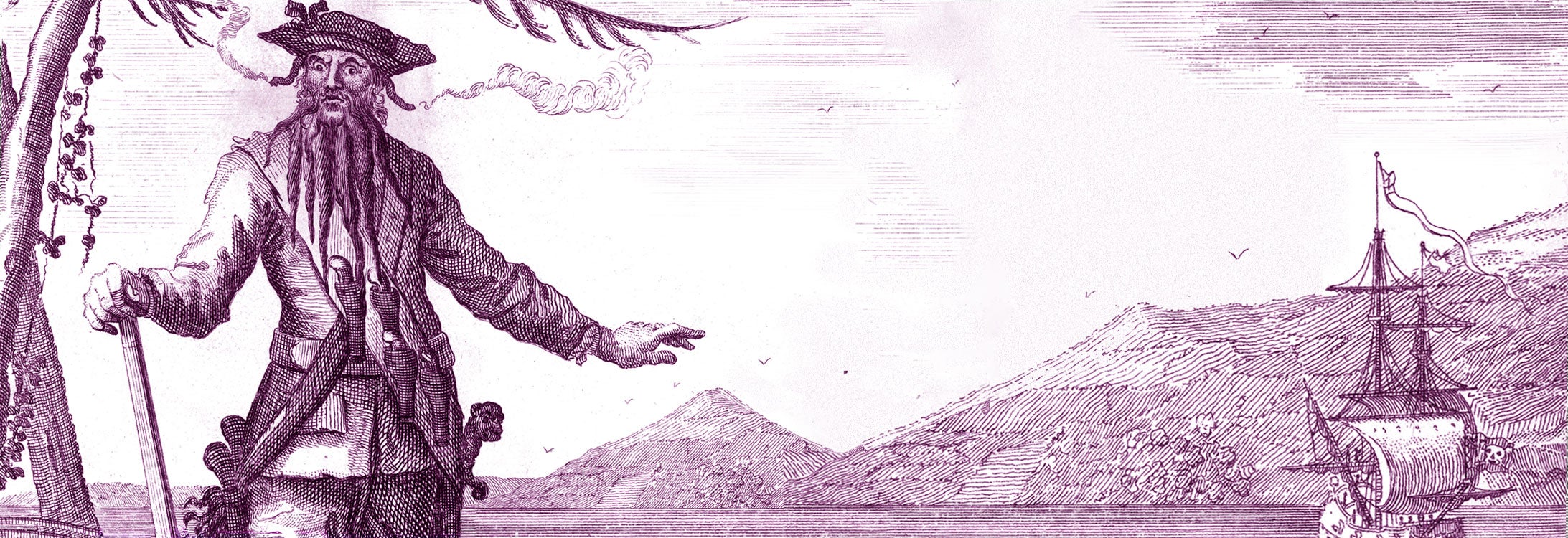A history of piracy
ECU marks three centuries of Blackbeard lore
In June 1718, Blackbeard grounded his flagship, the Queen Anne’s Revenge — perhaps deliberately — near what is now Beaufort Inlet. Five months later, British Navy Lt. Robert Maynard tracked down Blackbeard and his crew at Ocracoke, killed the world’s most infamous buccaneer and then beheaded the body.
In the 300 years since, the fearsome pirate’s reputation has only grown. Legend has it his headless body swam three times around the ship before it sank. While such outlandish claims are impossible to prove or dispute, today there is a growing body of knowledge of life aboard Blackbeard’s ship, thanks to the discovery of the remains of the Queen Anne’s Revenge in 1996 and to more than two decades of painstaking work recovering and conserving artifacts from the wreck.
It’s only fitting that ground zero for that conservation effort is on the campus of East Carolina University, home of the Pirates. Inside the QAR Conservation Lab on ECU’s West Research Campus, the artifacts are X-rayed, cleaned, desalinated, dried and analyzed. Hundreds of thousands of individual artifacts have been recovered from the sea floor.
“East Carolina University does a lot of things very well, but of all the things we do well, there is one that we do better than anybody else anywhere, and that’s pirates and piracy,” says Dr. William Downs, dean of the Thomas Harriot College of Arts and Sciences. “It’s who we are and it’s what we do.”

Above, workers installed artifacts from the Queen Anne’s Revenge along with other pirate related paraphernalia for “Blackbeard 300,” a traveling exhibit hosted at Joyner Library in October and November. The exhibit included artifacts that represent weaponry, nautical tools and personal items – even dinner plates and cask hoops. Also displayed was “Blackbeard Fact & Fiction,” an exhibit exploring the fascinating world of Blackbeard through historical texts and fiction taken from the library’s own rare book collection. Photos by Cliff Hollis.
Once they’re conserved, the most remarkable artifacts go on display for the public at the N.C. Maritime Museum in Beaufort and in a traveling exhibit. This year, to commemorate the 300th anniversary of the wreck of the Queen Anne’s Revenge and the death of Blackbeard, ECU’s Joyner Library exhibited a selection of artifacts.
The exhibit included weaponry, nautical tools and personal items ranging from cannonballs, lead shot and gun flint to grinding stones, dinner plates, thumb screws and cask hoops. Upstairs in Joyner’s North Carolina Collection, a selection of titles from the library’s Rare Book Department explore the evolution of Blackbeard’s story. In conjunction with the exhibits, the university hosted a number of lectures, discussions and other events, including a Voyages of Discovery lecture by pirate historian Angus Konstam.
The wreck of the Queen Anne’s Revenge is a “piratical time capsule of international importance,” Konstam says. “It’s fantastic because we just have this wealth of material from these huge six-pounder cannons, which weigh three-quarters of a ton, down to little fragments of a pocket watch or beads, all of which tell a story.”
During his lecture, Konstam outlined what is known about Blackbeard, historical debates over what is fact and what is fiction and how new scholarship, including the findings of the QAR project, has contributed to the historical record.
“There are so many loose ends to the story, so many unanswered questions,” he says, including the location of Blackbeard’s birth and how he spent the years before his appearance as a privateer in the Caribbean. Even Blackbeard’s real name is an unsettled debate; it is commonly accepted as Edward Teach but also appears in historical records in other forms such as Thatch, Thach, Tack and Theach.
In its pursuit of the truth about Blackbeard and his ship and crew, the QAR lab has made a number of remarkable discoveries since it was established in 2004, not the least of which is an accumulation of evidence to help settle the debate about whether the wreck really is the Queen Anne’s Revenge. Its size and location, a ship’s bell dated 1705 and a lack of artifacts dated past 1718 all support the case, but it was the discovery of draught markings on the stern post — using French measurements consistent with the origin of the ship as the French slaver La Concorde — that helped convince researchers in 2011.
Gold dust from West Africa served as further corroboration of the ship’s history as a slave transport and helped seal the deal for David Moore, curator of nautical archaeology for the N.C. Maritime Museum, who also spoke on ECU’s campus during a Blackbeard 300 event.
About 14,000 grains of gold have been recovered, but it is not the treasure that number might suggest. It’s only about an ounce of gold by weight, says Kimberly Kenyon, QAR project conservator. The lack of a legendary pirate bounty aboard the wreck is attributed to the hypothesis that Blackbeard ordered his crew to ground the ship and remove most items of value.
While the cannons themselves — 24 have been recovered so far; 16 are currently in various stages of conservation in the lab — are a conversation starter, perhaps the most remarkable find has been several fragments of paper found in the wadding of one of the weapons. Conservators were able to preserve the parchment and discovered it contained legible text.
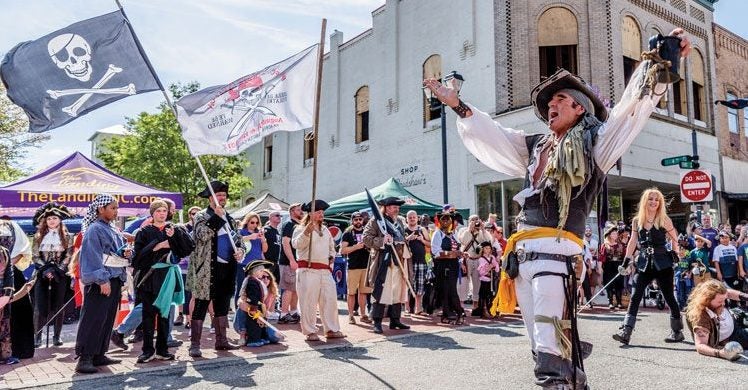
BE A PIRATE AT PIRATEFEST
PirateFest is the region’s signature community event celebrating eastern North Carolina’s rich pirate history. The festival draws an estimated 30,000 people and more than 150 vendors for two days of live music, delicious and unique food, an art sale, roaming pirates and more. It all takes place April 12-13 on Evans Street between First and Fifth streets and along East Third Street in Greenville.
More information is available at piratefestnc.com.
With the help of experts such as Joyner Library conservator Larry Houston, the fragments were determined to be from a 1712 first edition of Captain Edward Cooke’s “A Voyage to the South Sea, and Round the World.” Joyner has a copy of the book, which was included in the Blackbeard exhibit.
“Seeing these really heavily degraded paper fragments was really kind of cool because it isn’t something I normally deal with,” Houston says. “Most of our books haven’t been under water for 300 years.”
Other books in the Blackbeard exhibit show how his legend has grown over time. One of the earliest depictions of the pirate is in the 1724 first edition of “A History of the Pyrates” by Captain Charles Johnson, believed to be a pseudonym for Daniel Defoe. He holds a sword and carries six small pistols in a bandolier.
“As you go through time with pictures of him, the guns on his bandolier get bigger and bigger,” Houston says. By the 20th century and depictions like Disney’s “Blackbeard’s Ghost,” also on display, the size and quantity of weapons carried by the pirate are outlandish. His beard grows as well and is sometimes shown with smoking fuses interwoven.
While the exhibits at Joyner were temporary, the books in the collection remain available to students and the public at the library, and the QAR lab hosts tours and other special events to provide an opportunity to share its artifacts and research.
“We tend to collect heavily in the areas of maritime history and, of course, pirates, since we are Pirates after all,” says Houston. “We have all types of books about the history of pirates and the ways in which they’re depicted.”
In the early 1700s, North Carolina was a natural haven for buccaneers for a variety of reasons, from its shallow waters to its less-developed economy, which meant less oversight from the authorities. Today, ECU and the QAR lab continue to research one of the most significant wrecks of the era, the Queen Anne’s Revenge.
Greenville and ECU, after all, are the home of the Pirates.
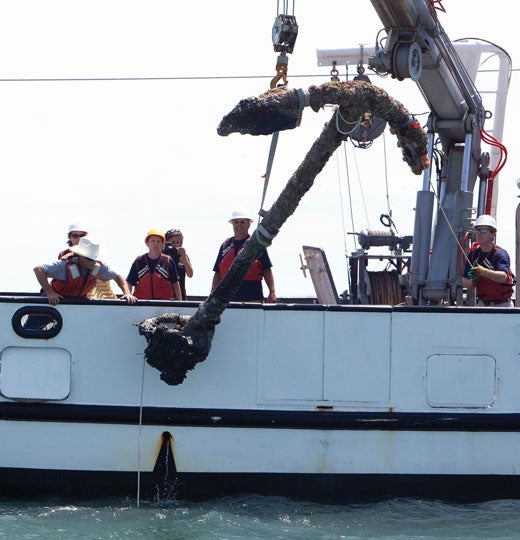
Researchers recovered an anchor from a shipwreck believed to be that of pirate Blackbeard’s flagship, the Queen Anne’s Revenge, in 2011 in the waters near Beaufort Inlet.
More information about current and upcoming exhibits at Joyner Library is at library.ecu.edu
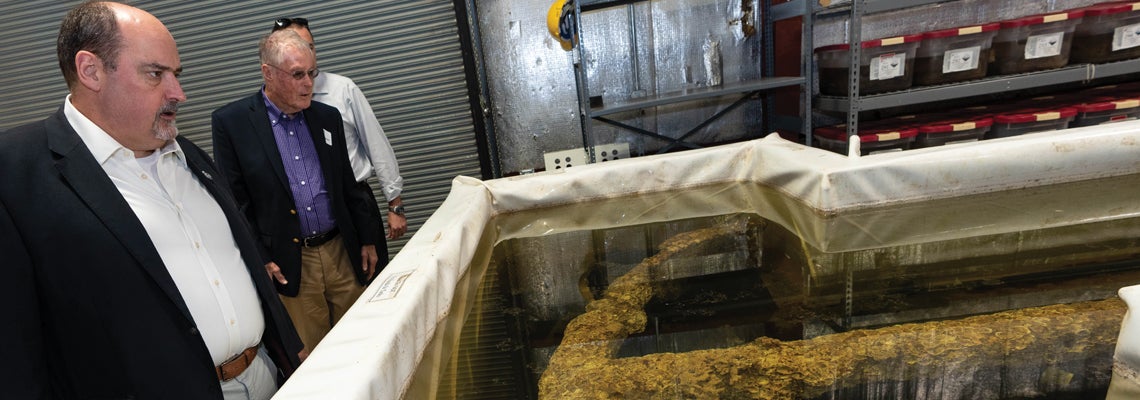
Author, historian and world-renowned pirate expert Angus Konstam looks over the anchor believed to be from Blackbeard’s flagship, the Queen Anne’s Revenge, at the Queen Anne’s Revenge Conservation Lab, housed at ECU’s West Research Campus.
PEEDEE THE PIRATE TURNS 35
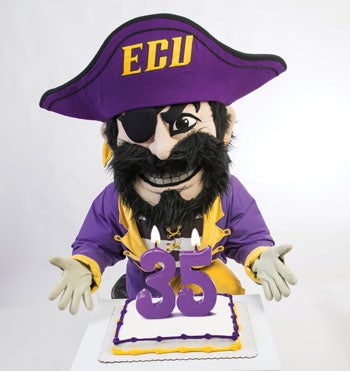 As ECU commemorates the 300th anniversary of Blackbeard’s death, another pirate celebrates a milestone as well — PeeDee, the mascot for ECU and its athletic teams, is 35. A contest was held in 1983, and elementary students in Pitt County voted to name the mascot PeeDee, after the river, which was said to have been home to pirates in colonial times.
As ECU commemorates the 300th anniversary of Blackbeard’s death, another pirate celebrates a milestone as well — PeeDee, the mascot for ECU and its athletic teams, is 35. A contest was held in 1983, and elementary students in Pitt County voted to name the mascot PeeDee, after the river, which was said to have been home to pirates in colonial times.
Officially, the nickname was dropped by the chancellor two years later after students complained that they’d had no say in naming the mascot. But more than three decades later, the moniker remains.
While PeeDee is but a spry 35 years old, ECU and its student-athletes have been associated with pirates for much longer.
“In February 1934, the Pirates became the official name for the college’s sports teams,” according to Henry C. Ferrell Jr.’s “No Time for Ivy,” a university history published in 2006. “Some years would pass, however, before the familiar ‘Teachers’ logo disappeared from uniforms or newspaper reports.”
At about the same time, the first renderings of a “beady-eyed” pirate appeared as an athletics namesake, emerging from stories of Blackbeard and “his coastal swag-hungry marauders,” says Ferrell in the book.
A pirate was also included in the school seal adopted in 1951, but live animal mascots appeared throughout the 1950s, ‘60s and ‘70s, including a Great Dane and a poodle.
